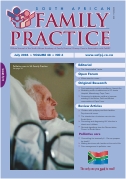Morbidity profile of admissions to GF Jooste Hospital, Manenberg, Cape Town
Abstract
Background Secondary hospitals play an important, yet overlooked, role in reflecting public health status, both locally and nationally. Relatively few reports analysing the causes of secondary hospital admissions exist, which is especially unfortunate in the case of developing countries, considering the huge numbers of admissions and people at risk. In developing countries like South Africa, the quality of records varies among institutions. Some hospitals have computerised data, while others may keep no records whatsoever. A major problem facing the quality of hospital records is the constant shortage of staff in rural and urban hospitals. Thorough documentation is essential in providing an invaluable database for researchers, but morbidity statistics are unfortunately scarce. GF Jooste Hospital in Manenberg is the busiest hospital in Cape Town – serving 1.1 million people, with 224 beds and over 12 000 admissions annually. Budgetary constraints in the South African public health sector means that providing healthcare services at higher levels than necessary is too costly. Because hospitals consume the largest share of the public healthcare budget, they have been the focus in cost cutting. In particular, the budgets of referral (tertiary or teaching) hospitals have been trimmed in order to promote primary and secondary care. It is imperative to identify those services that are required most at secondary hospitals in order to improve budgeting and, more appropriately, train doctors and medical students for the job at hand. Identifying the morbidity profile of the population for which the hospital caters can aid the optimal utilisation of the available resources, as well as focusing the continuing medical education of hospital physicians. We determined disease patterns of admissions over a three-year period (2001-2003), primarily as insight towards optimal hospital resource management. Methods A retrospective study examined ward records, totalling 36 657 admissions, from which a random sample (N=608) was selected. A stratified sample (N=462) was constructed, considering the relative proportions admitted to the wards. The International Statistical Classification of Diseases (ICD) directed diagnosis sorting. Disease prevalence was expressed as the percentage of patients allocated to each ICD category among those admitted to the hospital and respective wards and, additionally, the percentage of diagnoses for each ICD subcategory among patients assigned to each major category. Results Trauma (represented by ICD categories S/T 23% and V/X/Y 16%), specifically assault-related, was most prevalent. This was followed by circulatory diseases (22%) and infectious diseases (19%), dominated by HIV (61%) and associated diseases like TB (57%). The age of the patients ranged from 13 to 87 (mean: 40 years), with the 20 to 30-year-olds predominating. Surgical patients were younger (mean: 35 years) than medical (mean: 45 years). In the medical wards, infectious (39% in men; 38% in women) and circulatory aetiologies (39% and 41% in men and women respectively) dominated. In the surgical wards, the trend varied according to sex: assault (43%) and other injuries (61%) for males; pregnancy-related (42%) for females. Conclusion The morbidity distribution reflects the ills affecting South African urban society, with young trauma admissions predominating. The hospital’s budget is insufficient, considering its population’s demands. SA Fam Pract 2006;48(6): 15)
Issue
Section
Original Research
By submitting manuscripts to SAFP, authors of original articles are assigning copyright to the South African Academy of Family Physicians. Copyright of review articles are assigned to the Publisher, Medpharm Publications (Pty) Ltd, unless otherwise specified. Authors may use their own work after publication without written permission, provided they acknowledge the original source. Individuals and academic institutions may freely copy and distribute articles published in SAFP for educational and research purposes without obtaining permission.

